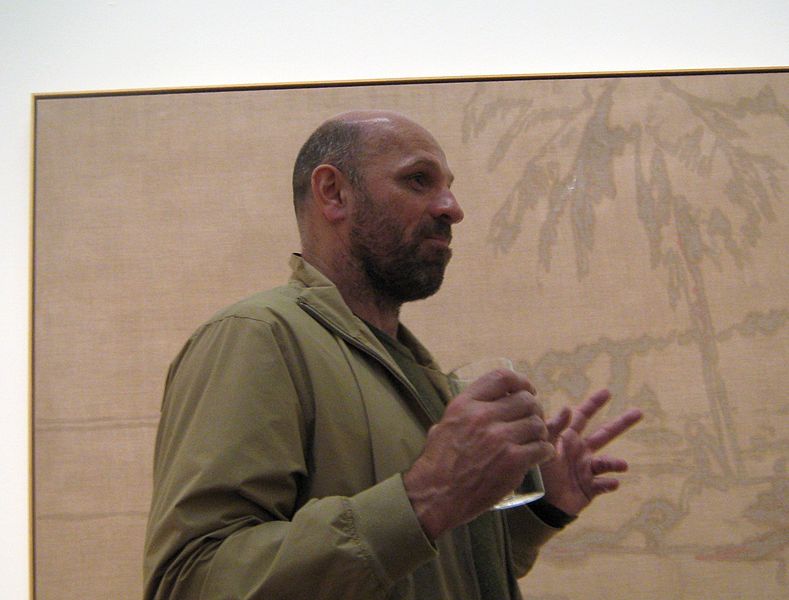Swamp and Cinema: Peter Doig in Montreal

Swamps bring out the best in Peter Doig. His paintings are full of wilting palms and marshy grass, dark water and veils of Spanish moss. With the dozens of canvases in No Foreign Lands, the retrospective of his work now finally on at Montreal’s Museum of Fine Arts, we are constantly being taken to the swamps and bayous of Trinidad, where Doig lives. He was born in Edinburgh, spent part of his adolescence in Toronto, and studied art in London. But it’s Trinidad, where he moved in 2002, that animates his most interesting work in this show. The plant life in Grand Riviere (2001-02) seems to melt with tropical heat. Pelican (Stag) (2003) suggests the kind of windless Caribbean night that forces men to go shirtless. Even when he’s in France, he’s in the West Indies: Stag (2002-5) shows a wino leaning on a post outside a Paris metro stop, but jungle foliage looms on the edge of the picture.
Channeling Gaugin, Doig sets off occasional explosions of cotton candy pink and lemon meringue yellow, but his regular palette is suggestively murky. Suggestive because it establishes the mood for the mysterious, tension-filled stories that play out in his paintings. The characters in these stories are disturbingly ambiguous. Doig makes you pore over them like they’re stills in the Zapruder film. They’re all hints, outlines, ghostly and ungraspable.
100 Years Ago (2000) shows us a man in a red canoe, floating in weirdly placid, chlorine-blue water. There’s an island behind him on the horizon, dotted with institutional buildings. The man has long, greasy hair and a handlebar mustache; he wears a kind of sleeveless tunic. It could be Charles Manson. The questions start piling up: who is this? Why is he looking at us? Where does the canoe come from? Has he escaped from the island on the horizon? Where is he going?
Boats—red boats, even—are a recurring motif in Doig’s work: they give access to the swamp. Sometimes the boats are more real than the people they carry. The title of Red Boat (Imaginary Boys) (2003-04) suggests the artist’s propensity for making the raw, inanimate world more stable and coherent than his human figures. In Pelican (2004), a man staggers along a beach at the edge of a forest. His body is intact, but his face is translucent, disappearing into the undergrowth behind him, like one of Francis Bacon’s popes.
It gives the impression of an early, washed-out Daguerreotype photograph, the kind where the grim Victorian faces are blurred and spooky. The look of photography and film suffuses Doig’s work. The occasionally corroded look of his surfaces can bring to mind film melting in a projector. Above all, the propulsive narrative energy of his best work can tighten the chest like a thriller.
The most chest-tightening picture in the show is Figures in Red Boat (2005-07). It draws together all of Doig’s most characteristic effects: landscapes imagined with the vividness of a dream; surreal, moody colouring; the vision of a zero-sum game between nature and humanity; the use of narrative. Six faceless men sit in a red motorboat; sky and water are the same otherwordly mauve. At the bow, one of the spectres stares back at the viewer, or seems to; his posture and the cast of his head say he’s noticed you, and he’s not happy about it. You’ve stumbled into something illicit—a drug run, or the dumping of a body maybe. The other five figures appear oblivious to your presence, as if the painting were capturing the second before a bout of trouble starts. It’s an ingenious tactic: Doig makes you more than a voyeur; he makes you an actor in the drama unfolding on the canvas.
It’s fitting that the show ends with the posters Doig has painted for weekly screenings of his Port-of-Spain film club. He’s done these deft pastiches for dozens of movies: Some Like It Hot, Old Boy, Grizzly Man, Jules and Jim. For all of his obvious painterly influences—Gaugin and Bacon, but also Vuillard and Vermeer, Tom Thompson and William Kurelek—the Fine Arts retrospective shows a profoundly cinematic painter at work.
Peter Doig: No Foreign Lands runs until May 4 at the Montreal Museum of Fine Arts, 1380 rue Sherbrooke Ouest.





